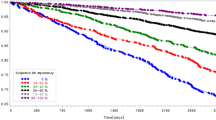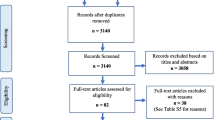Abstract
Purpose
To investigate which aspects of Quality of Life (QoL) (physical health, psychological, social-relationships, and environment) are important in predicting mortality.
Methods
A sample of 448 (194 men and 254 women) relatively healthy older adults reported their QoL using the WHOQOL-BREF. After a 9-year follow-up, survival analysis was carried out using Cox’s proportional hazards regression.
Results
Only the General Health item (HR = 0.75, 95% CI: 0.64–0.89) and Physical Health Domain mean score (HR = 0.90, 95% CI: 86–0.95) significantly predicted mortality when controlling for age and sex. The single-item General Health measure was the stronger predictor of mortality and remained significant after socio-demographic, psychological (personality and cognition), health behaviour and health status measures were controlled for independently. When all measures were simultaneously controlled for, none of the items or domains on the WHOQOL-BREF significantly predicted mortality.
Conclusion
Items addressing health-related QoL are the most important when predicting mortality. The findings support research demonstrating that subjectively rated, single-item general health questions accurately predict survival over and above socio-demographic, psychological, health behaviour and health status measures.



Similar content being viewed by others
Abbreviations
- WHOQOL-BREF:
-
Brief version of the World Health Organisation Quality of Life Questionnaire
- WHO:
-
World Health Organisation
- QoL:
-
Quality of life
- HR:
-
Hazard ratio
- HRQoL:
-
Health-related quality of life
- LBC1921:
-
Lothian Birth Cohort 1921
- GROS:
-
General Register Office for Scotland
- CI:
-
Confidence interval
- NEO-FFI:
-
NEO-Five Factor Inventory
- IPIP:
-
International Personality Item Pool
- SMS1932:
-
Scottish Mental Survey 1932
- MHT:
-
Moray House Test
- WTCRF:
-
Wellcome Trust Clinical Research Facility
References
Mossey, J. M., & Shapiro, E. (1982). Self-rated health—a predictor of mortality among the elderly. American Journal of Public Health, 72, 800–808.
Jylha, M. (2009). What is self-rated health and why does it predict mortality? Towards a unified conceptual model. Social Science and Medicine, 69, 307–316.
Ware, J. E., Jr., & Sherbourne, C. D. (1992). The MOS 36-item short-form health survey (SF-36). I. Conceptual framework and item selection. Medical Care, 30, 473–483.
Shadbolt, B., Barresi, J., & Craft, P. (2002). Self-rated health as a predictor of survival among patients with advanced cancer. Journal of Clinical Oncology, 20, 2514–2519.
Hofhuis, J. G., Spronk, P. E., van Stel, H. F., Schrijvers, A. J., & Bakker, J. (2007). Quality of life before intensive care unit admission is a predictor of survival. Crit. Care, 11, R78.
Mathews, W. C., & May, S. (2007). EuroQol (EQ-5D) measure of quality of life predicts mortality, emergency department utilization, and hospital discharge rates in HIV-infected adults under care. Health Qual. Life Outcomes, 5, 5.
Idler, E. L., & Benyamini, Y. (1997). Self-rated health and mortality: a review of twenty-seven community studies. J. Health Social Behav., 38, 21–37.
DeSalvo, K. B., Bloser, N., Reynolds, K., He, J., & Muntner, P. (2006). Mortality prediction with a single general self-rated health question. A meta-analysis. Journal of General Internal Medicine, 21, 267–275.
Benyamini, Y., Blumstein, T., Lusky, A., & Modan, B. (2003). Gender differences in the self-rated health-mortality association: is it poor self-rated health that predicts mortality or excellent self-rated health that predicts survival? Gerontologist, 43, 396–405.
The WHOQOL Group. (1998). Development of the world health organization WHOQOL-BREF quality of life assessment. Psychological Medicine, 28, 551–558.
The WHOQOL Group. (1998). The world health organization quality of life assessment (WHOQOL): development and general psychometric properties. Social Science and Medicine, 46, 1569–1585.
The WHOQOL Group. (1995). The world health organization quality of life assessment (WHOQOL): position paper from the World Health Organization. Social Science and Medicine, 41, 1403–1409.
Kao, S., Lai, K. L., Lin, H. C., Lee, H. S., & Wen, H. C. (2005). WHOQOL-BREF as predictors of mortality: a two-year follow-up study at veteran homes. Quality of Life Research, 14, 1443–1454.
Deary, I. J., Whiteman, M. C., Starr, J. M., Whalley, L. J., & Fox, H. C. (2004). The impact of childhood intelligence on later life: following up the Scottish mental surveys of 1932 and 1947. Journal of Personality and Social Psychology, 86, 130–147.
Folstein, M. F., Folstein, S. E., & McHugh, P. R. (1975). Mini-mental state. A practical method for grading the cognitive state of patients for the clinician. Journal of Psychiatric Research, 12, 189–198.
Thomas, B. M., Starr, J. M., & Whalley, L. J. (1997). Death certification in treated cases of presenile Alzheimer’s disease and vascular dementia in Scotland. Age and Ageing, 26, 401–406.
Gow, A., Whiteman, M. C., Pattie, A., & Deary, I. J. (2005). The personality-intelligence interface: insights from an ageing cohort. Pers Individ. Differ., 39, 751–761.
von Steinbuchel, N., Lischetzke, T., Gurny, M., & Eid, M. (2006). Assessing quality of life in older people: psychometric properties of the WHOQOL-BREF. European Journal of Ageing, 3, 116–122.
Kalfoss, M. H., Low, G., & Molzahn, A. E. (2008). The suitability of the WHOQOL-BREF for Canadian and Norwegian older adults. European Journal of Ageing, 5, 77–89.
Lai, K. L., Tzeng, R. J., Wang, B. L., Lee, H. S., Amidon, R., & Kao, S. Y. (2005). Health-related quality of life and health utility for the institutional elderly in Taiwan. Quality of Life Research, 14, 1169–1180.
The WHOQOL Group. WHOQOL-BREF. Introduction, administration, scoring and generis version of the assessment. Field Trial Version, 1996.
General Register Office. (1956). Census 1951: Classification of Occupations. London: HMSO.
Deary, I. (2008). Why do intelligent people live longer? Nature, 456, 175–176.
Batty, G. D., Deary, I. J., & Gottfredson, L. S. (2007). Premorbid (early life) IQ and later mortality risk: systematic review. Annals of Epidemiology, 17, 278–288.
Shipley, B. A., Der, G., Taylor, M. D., & Deary, I. J. (2008). Cognition and mortality from the major causes of death: the Health and Lifestyle Survey. J. Psych. Res., 65, 142–152.
Scottish Council for Research, Education. (1933). The Intelligence of Scottish children: A National Survey of an Age-group. London: University of London Press.
L.R. Goldberg, International Personality Item Pool. Web address can be obtained from authors, 2001.
Taylor, M. D., Whiteman, M. C., Fowkes, G. R., Lee, A. J., Allerhand, M., & Deary, I. J. (2009). Five Factor Model personality traits and all-cause mortality in the Edinburgh Artery Study cohort. Psychosomatic Medicine, 71, 631–641.
Weiss, A., & Costa, P. T. (2005). Domain and facet personality predictors of all-cause mortality among Medicare patients aged 65 to 100. Psychosomatic Medicine, 67, 724–733.
Weiss, A., Gale, C. R., Batty, G. D., & Deary, I. J. (2009). Emotionally stable, intelligent men live longer: the Vietnam Experience Study cohort. Psychosomatic Medicine, 71, 385–394.
Shipley, B. A., Weiss, A., Der, G., Taylor, M. D., & Deary, I. J. (2007). Neuroticism, extraversion, and mortality in the UK Health and Lifestyle Survey: a 21-year prospective cohort study. Psychosomatic Medicine, 69, 923–931.
NHS: NHS Choices: Know your limits, http://www.drinking.nhs.uk, 2010.
Starr, J. M., McGurn, B., Whiteman, M., Pattie, A., Whalley, L. J., & Deary, I. J. (2004). Life long changes in cognitive ability are associated with prescribed medications in old age. Int. J. Geriatric Psychiatr., 19, 327–332.
SPSS 14.0 for Windows. (2005). SPSS 14.0 for Windows. Chicago Illinois: SPSS Inc.
Acknowledgments
Wave one of the Lothian Birth Cohort 1921 Study (1999–2001) was funded by a Biotechnology and Biological Sciences Research Council grant (BBSRC). Funding for the Self-Reported Quality of Life Questionnaires (2001) and later follow-up waves came from the Chief Scientist’s Office (part of the Scottish Government Health Directorates). The current analysis was undertaken by The University of Edinburgh Centre for Cognitive Ageing and Cognitive Epidemiology, part of the cross council Lifelong Health and Wellbeing Initiative; this is funded by BBSRC, EPSRC, ESRC and MRC. We thank Alison Pattie, Martha Whiteman, Alan Gow and Beverley Roberts for data collection and collation.
Author information
Authors and Affiliations
Corresponding author
Rights and permissions
About this article
Cite this article
Murray, C., Brett, C.E., Starr, J.M. et al. Which aspects of subjectively reported quality of life are important in predicting mortality beyond known risk factors? The Lothian Birth Cohort 1921 Study. Qual Life Res 20, 81–90 (2011). https://doi.org/10.1007/s11136-010-9718-1
Accepted:
Published:
Issue Date:
DOI: https://doi.org/10.1007/s11136-010-9718-1




